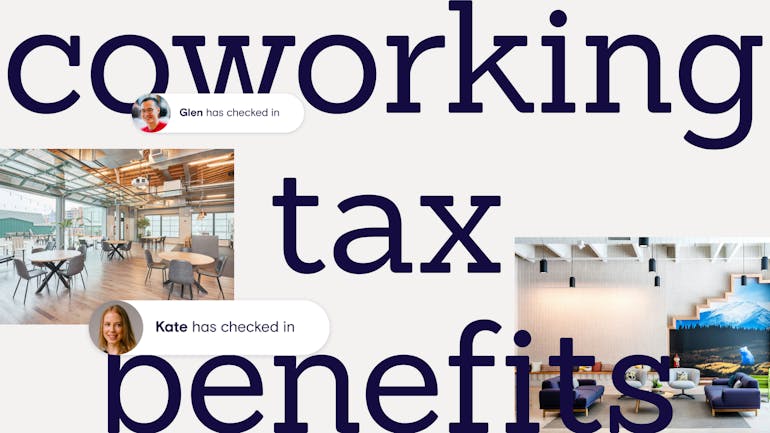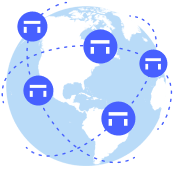When it comes to productivity in the workplace, there’s no one-size-fits all approach. While some employees feel happiest working in a collaborative coworking environment, others prefer the predictable environment of their home office. With hybrid work, teams can work when and where they are most productive, whether that is in-person at the office, at home, or from a coworking space.
Studies show that most workers prefer a hybrid work model, largely because they value the flexibility it offers. According to a recent study from JLL, upwards of 70-percent of employees prefer hybrid work to strictly working from the office or from home. It’s a win for employers, too.
They can tap into a larger talent pool and really curate a diverse, inclusive company culture.
Whether you’ve fully embraced the hybrid work model or planning to make the switch soon, here’s how to make for a successful transition.

Create a clear action plan
Before making the switch to hybrid work, define your company’s specific goals. Nail down both short-term and long-term goals and how your company plans to execute on each. Consider the location of your employees, the benefits they value and how to motivate their best work. Things change, of course, but having a plan in place will help guide future decision making.
One important component of an action plan is the ‘how’.
- How is your team going to make this transition?
- Will you keep a few offices for in-person workers or will you gradually scale back your real estate footprint in favor of coworking spaces and work-from-home allowances?
- How will your teammates continue to meet with each other and collaborate?
- Is there any specific training your team will benefit from?
- What changes should you anticipate during this time?
Prioritize streamlined communication
In a hybrid world, communication is king. With a distributed team, using collaboration tools helps to streamline internal communication.
Utilize collaboration tools like Slack and/or Teams
As we outlined in our guide to onboarding, Slack is our main form of communication and we pride ourselves on being clear, efficient, and thoughtful with our communication. It’s a great way to communicate with our broader team throughout the day asynchronously and an easy tool to escalate essential issues throughout the team immediately.
Slack keeps everyone up to date and allows team members to set their ‘online’ and ‘offline’ hours so that others know when they are and are not available. Creating guidelines around Slack features, such as public channels and direct messaging, adds organization and clarity to individual tasks and company-wide goals.
That said, Slack fatigue is real, so we put into play a few guidelines. First, we limit direct messages to three people. This is because, often-times, if more people are required to be looped in a conversation, it warrants the usage of a channel related to that subject. All our team channels are public, and our default communication takes place in these. Private channels are best limited to discussions of sensitive or confidential matters.
Microsoft Teams is another collaborative tool—our team doesn’t use it—but others do. Teams allows you to meet, chat, call and collaborate in just one place. A similar comparison to this is Google Suite, which is a collection of cloud-based tools, mainly: Drive (storage and organization), Docs, Sheets, and Slides.
Adapt an asynchronous communication style
In a synchronous communication style, workers are in touch with managers and colleagues throughout the day, and it’s expected that responses are made in real time. If you consider a typical office arrangement, this makes sense. It’s common for coworkers to pop by your desk for questions or to call you into the office for a last-minute meeting.
With a hybrid work model, however, there needs to be more flexibility in response times. An asynchronous communication means that while you will still be in touch with your team throughout the day and week, you don’t expect a response right away. Instead, you leave them with all the necessary information they will need to complete a task and they will complete this task in their own time and in advance of any set deadlines.
In switching from a synchronous to an asynchronous communication style, encourage daily check-ins to ensure that everyone is on the same page. Encourage questions while also allowing for autonomy. To increase clarity of communication and expectations, we advise team members to write in paragraph form rather than sending multiple one-line Slack messages which are harder to patch together a meaning from.
Be open to both structured and impromptu meetings
In an effort to respect everyone’s time, try to schedule meetings ahead of time and stick to the agenda whenever possible. Examples of scheduled, focused meetings might include launches or kickoffs, project check-ins, and other crucial topics like company pivots.
While these types of meetings are aimed at speaking openly and sharing ideas, most team members benefit from having a general agenda beforehand. This allows them time to properly prepare for the discussion and offer helpful insight. Have someone take minutes; this serves as a reference point for all, and a recap for those who missed the meeting.
That said, we’re all about an impromptu call or ‘huddle’ every now and again. From our perspective, it’s always helpful to get clarification whenever you’re stuck. If there’s something a team member is working on that they have questions around, we encourage them to speak directly to their supervisor (or whoever they are working with) on the phone or via a video call. This ensures that everyone is on the same page and there are no blocks. It saves time, adds clarity and maintains healthy communication.
Build a virtual community (to improve company culture)
We live in an increasingly digital world, and yet community remains a core component of any successful business. If the pandemic taught us nothing, it’s that we’re all in this together and that our home lives are equally important as our professional ones.
Encourage camera time on calls
One way to make remote workers feel more included in team calls is to encourage all members to join video calls from their computers. This includes team members that are working in-person at the office, as well as individuals working from home or a coworking space. This creates a more inclusive atmosphere than if remote team members were to join a call and see several colleagues sitting at a conference table and connected only from one person’s computer. We also encourage our team to turn their camera on during calls, but it’s always their choice.
Host virtual hangouts
During state-wide lockdowns in 2020, our team held monthly virtual hangouts as a way for everyone to meet together and share updates, both personally and professionally, with the team at large. Even with helpful collaboration tools like Slack and Google Meet, sentiments can get lost in translation. Virtual hangouts are an opportunity for teams to connect on a deeper level and to experience a deeper sense of community.
Create a learning hub
In our case, we recently created a #learning channel on Slack. We designed this as a place to discuss what our team is currently learning (whether personal or professional), to ask questions about topics they’re interested in, or to share helpful tips with teammates.
Educate employees on cyber security best practices
As teams become more dispersed, cyber security is more important than ever. After all, a company’s data is only as secure as the weakest individual link. Providing ongoing training around safety practices is helpful to enforce new behaviors such as enabling multi-factor authentication, using a password manager and utilizing virtual desktops in the cloud.
For a more comprehensive rundown, check out our post on cyber security best practices to follow.
Create equitable benefits
This is especially important if half of your team meets in-person and another percentage is fully remote. It’s easy for some employees to feel left out or not treated as well as their in-house colleagues and creating perks and benefits that cater to a remote workforce is one way to show employees that they are valued and still part of the team.
Send goodie bags to WFH employees
Whereas in-house team members may benefit from catered lunches, free coffee and snacks, birthday parties and after-work drinks, remote workers aren’t able to participate. Creating a different experience for them—whether it’s adding a monthly lunch budget to their pay or mailing them gift baskets every so often—can make employees feel less isolated and better appreciated.
Prioritize flexibility and growth
Working from home is great, but not all the time. The Deskpass network gives individuals and teams access to thousands of workspaces. There’s unlimited flexibility, no commitments and a convenient pay-as-you-go model. In addition to meeting rooms, many spaces on our network offer private offices that members can reserve by the day, week and month.
Frequently ask for feedback
Feedback is a huge part of our onboarding process and we collect feedback in a few different ways. During the self-guided process, new employees fill out a Q&A and at the end of their onboarding, it is reviewed with their manager. This is to make sure the manager can follow up on any questions they have or requests for additional training.
Check in on mental health
Unlike physical ailments, mental health struggles are harder to hide. The CDC notes that 1 in 5 American adults experience mental health problems, with 71% reporting at least one symptom of stress. Hybrid work has been shown to reduce stress levels, boost productivity, encourage a work/life balance and allow for autonomy. Make it a point to regularly check-in with your remote team, ask for feedback and make sure they are getting the support they need.
The Bottom Line
If you’re going hybrid and want to offer your team more flexibility, Deskpass is a great option. Team members can reserve shared coworking, meeting rooms and private offices as needed, in spaces that are convenient for them and that inspire their best work. Sign-up is free and you can cancel at any time.
Get a complimentary $250 Deskpass credit when you sign up for a Teams account today.



